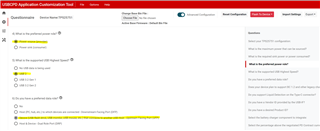Other Parts Discussed in Thread: TPS25751, TPS25750
Hello Experts
I am posting again here to get some clarity.
In my application there is a board which will receive data from the Samsung A8 tablet. Tablet will send data to my board using USB2.0 (DP, DM) lines of TYPE C port.
I want to design tablet charging and data communication circuit on my board. When the tablet is connected through its Type C port, my circuit should act like a DFP port (power source provider).
But the Tablet will be host (In terms of data role) and my micro-controller on the board will be the USB device receiving data from the tablet.
Maximum charging current required is 5V and 3A.
How can I do this ?
I checked TPS25830A-Q1 and it looks like one possible solution. According to data sheet It is a DFP device so it will provide charging power to the tablet.
But how will Tablet confirm that it is connected to a DFP device ? Which configuration pins on TPS25830 decides it ?
Also how data roles will be decided by the tablet (who is host and who is device) ?
Please suggest whether it can solve my purpose.


